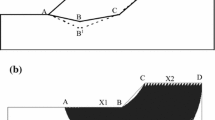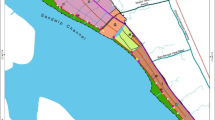Abstract
Stability of trenches in vadose zone primarily depends on matric suction distribution with depth. The depth of ground water table, type of soils, and local climate conditions such as rainfall are major contributing factors to the matric suction distribution, and thus the stability of unsupported trenches. Trench failures are labelled as the cause of many work-related injuries and deaths in the construction industry. Hence, the design of unsupported trenches should be done with utmost caution. The focus of this study is directed towards investigating the influence of rainfall infiltration on the stand-up time of unsupported vertical trenches excavated in unsaturated coarse- and fine-grained soils. For this, a series of numerical analyses were carried out to estimate stand-up time of unsupported vertical trenches considering possible practical scenarios such as various rainfall intensities and groundwater table depths, impermeable membranes on the ground surface, and tension cracks. The commercial geotechnical modelling software, GeoStudio was used in this study to simulate excavation, redistribution of pore-water pressure due to excavation, rainfall infiltration, and slope stability analysis.
Similar content being viewed by others
References
Bishop, A. W. and Bjerrum, L. (1960). “The relevance of the triaxial test to the solution of stability problems.” Proc., ASCE Res. Conf. on Strength of Cohesive Soils, ASCE, New York, N. Y., pp. 437–501.
Cho, S. E. and Lee, S. R. (2001). “Instability of unsaturated soil slopes due to infiltration.” Computers and Geotechnics, Vol. 28, No. 3, pp. 85–208, DOI: https://doi.org/10.1016/S0266-352X(00)00027-6.
Eivemark, M. and Hall, M. (2000). “Geotechnical considerations in trench design for lifelines.” Proc. of the 14th annual Vancouver Geotechnical Society Symposium, Vancouver, Canada, pp. 137–143.
Fredlund, D. G. and Xing, A. (1994). “Equations for the soil-water characteristic curve.” Canadian Geotechnical Journal, Vol. 31, No. 4, pp. 521–532, DOI: https://doi.org/10.1139/t94-061.
Fredlund, D. G., Xing, A., and Huang, S. (1994). “Predicting the permeability function for unsaturated soils using the soil-water characteristic curve.” Canadian Geotechnical Journal, Vol. 31, No. 4, pp. 533–546, DOI: https://doi.org/10.1139/t94-062.
Gui, M. W., and Han, K. K. (2008). “A case study on rainfall infiltration effect on the stability of two slopes.” Proc. of the 10th International Symposium on Landslides and Engineered Slopes, Xi’an, China, pp. 1737–1743.
Kwan, D. (1971). “Observation of the failure of a vertical cut in clay at Welland, Ontario.” Canadian Geotechnical Journal, Vol. 8, No. 2, pp. 283–298, DOI: https://doi.org/10.1139/t71-024.
Mohamed, F. M. O. and Vanapalli, S. K. (2006). “Laboratory investigations for the measurement of the bearing capacity of an unsaturated coarse-grained soil.” Proc. of the 59th Canadian Geotechnical Conference, Vancouver, Canada, pp. 219–226.
Ng, C. W. W. and Shi, Q. (1998). “A numerical investigation of the stability of unsaturated soil slopes subjected to transient seepage.” Computers and Geotechnics, Vol. 22, No. 1, pp. 1–28, DOI: https://doi.org/10.1016/S0266-352X(97)00036-0.
Occupational Safety and Health Administration (OSHA) (1990). Analysis of Construction Fatalities — The OSHA Data Base, pp. 1985–1989.
Oh, W. T. and Vanapalli, S. K. (2010). “Influence of rain infiltration on the stability of compacted soil slopes.” Computers and Geotechnics, Vol. 37, No. 5, pp. 649–657, DOI: https://doi.org/10.1016/j.compgeo.2010.04.003.
Pufahl, D. E., Fredlund, D. G., and Rahardjo, H. (1983). “Lateral earth pressures in expansive clay soils.” Canadian Geotechnical Journal, Vol. 20, No. 2, pp. 228–241, DOI: https://doi.org/10.1139/t83-027.
Richard, A. (2018). Estimating the critical height of unsupported trenches in unsaturated soil. Master’s Thesis, University of New Brunswick, New Brunswick, Canada.
Seki, K. (2007). “SWRC fit—a nonlinear fitting program with a water retention curve for soils having unimodal and bimodal pore structure.” Hydrology and Earth System Science, Vol. 4, No. 1, pp. 407–437, DOI: https://doi.org/10.5194/hessd-4-407-2007.
Stanier, S. A. and Tarantino, A. (2013). “An approach for predicting the stability of vertical cuts in cohesionless soils above the water table.” Engineering Geology, Vol. 158, pp. 98–108, DOI: https://doi.org/10.1016/j.enggeo.2013.03.012.
Suruda, A., Smith, G., and Baker, S. (1988). “Deaths from trench cave-in in the construction Industry.” Journal of Occupational and Environmental Medicine, Vol. 30, No. 7, pp. 552–555.
Thompson, L. J. and Tanenbaum, R. J. (1977). “Survey of construction related trench cave-Ins.” Journal of the Construction Division, Vol. 103, No. 3, pp. 501–512.
Vanapalli, S. K. and Oh, W. T. (2012). “Stability analysis of unsupported vertical trenches in unsaturated soils.” GeoCongress 2012, ASCE, Oakland, US, pp. 2502–2511.
Whenham, V., De Vos, M., Legrand, C., Charlier, R., Maertens, J., and Verbrugge, J. C. (2007) “Influence of soil suction on trench stability.” In: Schanz T. (eds) Experimental Unsaturated Soil Mechanics. Springer Proceedings in Physics, Vol 112. Springer, Berlin, Heidelberg, pp. 495–501, DOI: https://doi.org/10.1007/3-540-69873-6-49.
Williams, J. R., Ouyang, Y., and Chen, J. S. (1998). “Estimation of infiltration rate in vadose zone: Application of selected mathematical models — Volume II. U.S.” United States Environmental Protection Agency, EPA/600/R-97/128b (NTIS 98-147317).
Zhang, L. L., Zhang, L. M., Fredlund, D. G., and Tang, W. H. (2003). “Effect of rainfall intensity and duration on soil suction for two Hong Kong soils.” Proc. of the International Conference on Slope Engineering, Hong Kong, pp. 310–315.
Zhang, L. L., Zhang, J., Zhang, L. M., and Tang, W. H. (2011). “Stability analysis of rainfall-induced slope failure: A review.” Proc. of the Institution of Civil Engineers-Geotechnical Engineering, Vol. 164, No. 5, pp. 299–316, DOI: https://doi.org/10.1680/geng.2011.164.5.299.
Vanapalli, S. K., Fredlund, D. G, and Pufahl, D. E. (1997). “Saturated-unsaturated shear strength and hydraulic conductivity behavior of a compacted glacial till.” Proc. of the 50th Canadian Geotechnical Conference, Ottawa, Canada, pp. 625–632.
Acknowledgements
The second author thanks the support from Natural Sciences and Engineering Research Council of Canada (NSERC) for his research programs.
Author information
Authors and Affiliations
Corresponding author
Rights and permissions
About this article
Cite this article
Ileme, V., Oh, W.T. Estimating the Stand-Up Time of Unsupported Vertical Trenches in Vadose Zone. KSCE J Civ Eng 23, 4259–4273 (2019). https://doi.org/10.1007/s12205-019-0572-6
Received:
Revised:
Accepted:
Published:
Issue Date:
DOI: https://doi.org/10.1007/s12205-019-0572-6




